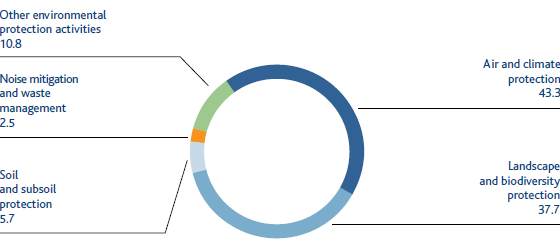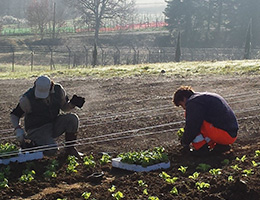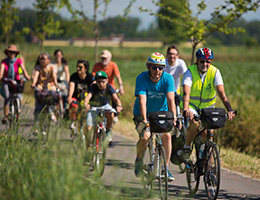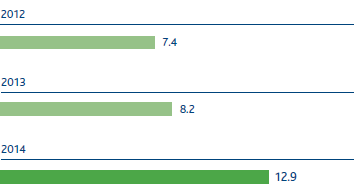Protecting the environment and biodiversity
GRI - G4: SO2, EN31
Safeguarding the environment is an integral part of corporate policy and investment decisions for all Snam’s activities, and the Company is fully committed to an approach in which the environment and economic development can go hand in hand, without neglecting the protection of local areas.
Snam adopts specific certified management systems for environmental matters to oversee corporate processes and activities. The key issues at global level, and the nature of Snam’s operations, have led the Company to focus on two main challenges: combating climate change and reducing energy consumption, and safeguarding nature and biodiversity.
This commitment is currently reflected in many areas: promoting sustainable use of natural resources; preventing pollution and protecting ecosystems and biodiversity; implementing operating and management actions to reduce greenhouse gas emissions, with an approach that aims to mitigate climate change; and managing waste to reduce its production and promote recovery at its final destination.
The responsibility for implementing the policy is shared by Snam’s HSEQ Corporate department, which focuses on the functions of coordination and general guidance for the entire Group, and the HSEQ structures in the individual companies that have the tasks of specific guidance, coordination and support for the relative operating units.
In 2014, environmental expenses amounted to €170.1 million (€155.1 million for investments and €15 million for management costs).
In order to develop new establishments, besides technical and economic feasibility criteria, Snam adopts procedures that meet stringent environmental compatibility and safety assessments.
Assessments of the effects on the environment concern all phases of a project’s life cycle: location, design, execution, operation and decommissioning. These assessments are made as part of the Environmental Impact Assessment (EIA), after which the administrations in charge, both centrally and locally, issue the authorisations provided for by current regulations.
With regard to developing the network of gas pipelines, which represents the most recurring and significant event, in the design phase the path is chosen from among different alternatives, seeking to avoid or reduce to the necessary minimum the network’s passage through areas of significant natural or cultural interest, archaeological areas, geologically unstable areas and developed areas or those in which new residential settlements are expected.
In special cases in the construction phase, procedures and technologies are used, consistent with technical feasibility, which lessen interference with the surrounding environment, such as reducing the extent of the work area, minimising provisional worksite infrastructure and trenchless execution techniques (tunnels and micro-tunnels), as alternatives to traditional excavation. Once installation is done, accurate environmental restoration activity is carried out so as to return the land to its original conditions.
ENVIRONMENTAL EXPENSES BROKEN DOWN BY TYPE (%)


Nurturing value: the company’s garden of Terranova Bracciolini
In 2014 Snam entered into an agreement with the Betadue Cooperative whereby it provided four years free use of a land parcel it owns located outside the headquarters in Terranuova Bracciolini (AR).
The Terranuova Bracciolini plant is surrounded by about four hectares of green area located outside the plant that is the site of a fruit and olive orchard (a total of about 150 fruit trees). This fenced area is segregated from the rest of the plant, and physically separated from it, and has characteristics suitable for growing vegetable crops and small garden plots. After scouting the area, Snam identified the Beta Cooperative as a partner. It is a type B non-profit social cooperative that pursues “the general interest of the community, the promotion of individuals and integration of citizens” through its activities. These activities include those targeting corporate agriculture and a short supply chain. Thus, Snam provides the land it owns free of charge to the Beta Cooperative. The Land is located at the plant site with all the facilities needed for the success of the project (irrigation and lighting systems), and for farming vegetables and fruit trees. The Beta Cooperative will use the products to increase the short supply chain and to restock the food chain of nursery schools managed by the cooperative. An area of the land covered by the project will be reserved for an educational garden that will be managed in collaboration with the families of the children using the canteen.

Tour of Italy in 80 bookstores
Bring Italy together through an ideal network of bookstores, pathways, museums and cities thanks in part to the support and experience of a network that respects the future. This is the goal of the “Tour of Italy in 80 Bookstores”, a cycling, cultural and environmental relay race along the ancient pathways of Via Francigena, organised by the Renewable Literature association from May to July in partnership with Snam.
The tour also included stops at several Group sites where cultural events were held encouraging participation and sharing with local communities. For example, at the Historical Archives and Italgas Museum in Turin, the Turin-based writer and journalist, Giuseppe Culicchia presented “Energy of the Land”, his theatrical play presenting the history of the company and its museum. At the Stogit facility in Ripalta Cremasca, several musicians initiated the “Melody of the Land”, a musical ensemble workshop carried out with the creative involvement of all hosts.
Before the grand finale of the Tour, which took place in Vasto, Stogit’s Abbruzzi facility on the Treste River greeted and hosted cyclists of the Tour along their path to Cupello, where, in a space belonging to the Municipality, the “Market of the Land” was organised to offer typical local farm products and involved local companies and producers.
| Download XLS (22 kB) |
|
EIA DECREES OBTAINED DURING THE YEAR |
||||
|
|
|
|
|
|
|
Name |
Length (km) |
Regions involved |
Competent agencies |
Date of decree |
|
Cervignano – Mortara |
62 |
Lombardy |
MATTM |
07/10/2014 |
|
Messina – Palmi |
29 |
Sicily – Calabria |
MATTM |
24/10/2014 |
| Download XLS (23 kB) |
|
PROVISIONS RECEIVED DURING THE YEAR FOR VERIFYING WHETHER A PROJECT IS SUBJECT TO EIA |
||||
|
|
|
|
|
|
|
Name |
Length (km) |
Regions involved |
Competent agencies |
Date of provision |
|
Sestino – Minerbio |
140.7 |
Tuscany – Emilia Romagna |
MATTM |
01/08/2014 |
|
Expansion of Fano network |
3.11 |
Marche |
Marche Region |
07/04/2014 |
|
Expansion of Reduction Plant No. 841 in Messina 75/12 bar |
– |
Sicily |
Region of Sicily |
24/02/2014 |
|
Connection of Total Tempa Rossa |
0.4 |
Basilicata |
Basilicata Region |
03/12/2014 |
|
Met. variances Chieti – Rieti / All.to Sacci / Ref. All.to Municipality of Pizzoli |
20.12 |
Abruzzo |
Abruzzo Region |
10/02/2014 |
| Download XLS (22 kB) |
|
EIA DECREES SUBMITTED TO REGIONAL AUTHORITIES IN THE YEAR |
||||
|
|
|
|
|
|
|
Name |
Length (km) |
Regions/Provinces involved |
Date of submission |
|
|
Raldon – Legnago expansion |
29.33 |
Province of Verona |
27/05/2014 |
|
| Download XLS (23 kB) |
|
PROVISIONS SUBMITTED DURING THE YEAR TO REGIONS OR PROVINCES FOR VERIFYING WHETHER A PROJECT IS SUBJECT TO EIA |
||||
|
|
|
|
|
|
|
Name |
Length (km) |
Regions/Provinces involved |
Date of submission |
|
|
Met. Coll. Pezzan – Lancenigo, Pot. Spina di treviso Nord and related projects |
5.75 |
Province of Treviso |
03/12/2014 |
|
|
Rif. Met. Vercelli – Romagnano Vercelli – Gattinara section and related projects |
32 |
Piedmont |
19/06/2014 |
|
|
Met. variances Spina di Corato and related projects |
5.25 |
Puglia |
19/09/2014 |
|
|
All.to Geogastock di Salandra |
0.12 |
Basilicata |
26/09/2014 |
|
Biodiversity GRI – G4: EN13, EN14; SO1
In terms of environmental sustainability, Snam considers it particularly important to safeguard the natural value of local areas affected by new works, beginning with specialised field investigations to learn as much as possible about the local area traversed. The results of these investigations help to define and implement the most appropriate design choices for reducing the impact on biodiversity to a minimum, generated, particularly in the execution phases, which are followed by environmental restoration and monitoring thereof, carried out in agreement and in cooperation with the entities in charge.
The objective of vegetation restoration, in particular reforestation, is not merely to reconstitute forest areas but to reconstitute the landscape in general and to revive the biological functionality of vegetated areas, which are especially important in their role as habitats for fauna with specific biodiversity characteristics. Restoration and reforestation are followed by the execution of “plant care”, i.e. caring for and maintaining the bedded-out plants for a period of at least five years.
Monitoring projects cover the routes of certain methane pipelines that interfere, even marginally, with natural local areas high in fauna and ecological value, and they are geared towards the verification of the process of renaturalising areas affected by projects, based on a comparison of conditions after restoration (“post-completion”) and the original conditions (“pre-completion”). Monitoring is normally performed for the most significant habitats identified in the design phase.
It is becoming increasingly difficult, during the design and construction of gas pipelines, avoid interference with the sites in the Natura 2000 network, since these are areas of environmental protection throughout the national territory. Therefore, if it is inevitable the interest of such a site, the construction of the pipelines is done by identifying the path less impacting for environments protected and adopting the less invasive techniques for the territory. The amount of kilometers that pass through the Natura 2000 network sites varies from year to year depending on the works carried out and as a function of the related territories crossed.
DISTANCE COVERED BY PIPELINES IN NATURA 2000 NETWORKING SITES (km)

| Download XLS (22 kB) |
|
NATURA 2000 SITES AFFECTED IN 2014 BY THE COURSE OF METHANE PIPELINES GRI – G4: EN11 |
|
|
|
|
|
Special Protection Zone/Site of EU interest |
km |
|
Source and high valley of the Fortore river |
2.25 |
|
Castelvetere woods in Val Fortore |
2.32 |
|
Castelpagano woods |
1.52 |
|
Sella di Vinchiaturo |
5.38 |
|
La Gallinicola – Monte Mileto – Monti del Matese |
1.41 |
|
Total |
12.88 |
| Download XLS (22 kB) |
|
ENVIRONMENTAL RESTORATION AND MONITORING (NETWORK km) |
|||
|
|
|
|
|
|
|
2012 |
2013 |
2014 |
|
Restoration |
193 |
131 |
78 |
|
Reforestation |
6 |
22 |
16 |
|
Plant care |
158 |
135 |
124 |
|
Environmental monitoring |
830 |
1,063 |
1,055 |
|
MAJOR ENVIRONMENTAL MONITORING AND RESTORATION DURING THE YEAR |
||
|
|
|
|
|
Entity |
Name |
Activities performed |
|
Friuli-Venezia Giulia Region |
“Malborghetto – Bordano” methane pipeline |
In the Malborghetto – Bordano section of the pipeline, in the Val Alba regional nature reserve, the ten-year fauna research and monitoring activities continued with the help of international experts. 2014 was the tenth and last year of fauna monitoring. |
|
Sicily Region |
“Bronte – Montalbano” methane pipeline |
Collaboration with the Sicily state forests agency continued, with the growing of native forest plants destined for reforestation projects along the course of the pipelines laid in the Nebrodi regional park. Periodic plant care was carried out in 2014, along with the replacement of plants that had not taken root. Replacement plants are also supplied by the Sicily state forests agency nurseries. |
Safeguarding biodiversity GRI – G4: EN12
In 2014 the fifth and last year of environmental monitoring of the Grottole-Albano methane pipeline in Lucania was carried out. The pipeline is about 28 km long and crosses the territory of the provinces of Matera and Potenza in Basilicata. In particular, the methane pipeline runs through the valley of Basento river in an area that is partially protected due to the presence of SIC IT9220260 “Val Basento – Grassano S. – Grottole” and hillsides of an area that partly falls under the protected area of the “Gallipoli Cognato – Piccole Dolomiti Lucane” Natural Park.
The crossing within the site is 6.6 km long and covers municipal land in Calciano and Grassano in the province of Matera. The section crosses several natural environments identified as habitats of interest to the EU: “Sub-steppe courses of graminaceous and annual plants (Thero-Brachypodietea)”, “Landlocked rivers with a permanent flow with Paspalo-Agrostidion and riverine rows of Salix and Populus Alba”, “Prairies and nitrophilous shrubs (Pegano-Salsoletea)”.
The crossing within the “Gallipoli Cognato – Piccole Dolomiti Lucane” Natural Park is about 5.7 km long, in the area of Calciano, and mainly affected agricultural areas, uncultivated areas, pasture lands alternating with areas with patchy shrubs and trees, and small wooded sections. In this area, the route of the methane pipeline only indirectly affected SIC/ZPS IT 9220130 “Di Gallipoli Cognato Forest” (i.e., without crossing it, but with a short section near its perimeter).
Environmental monitoring was aimed at verifying changes in ecosystems over the five years after restoration was completed with a comparison with conditions before the project, and at depicting plant and animal biodiversity factors. The following environmental components were monitored: vegetation, soil and fauna.
Vegetation and soils were monitored in relation to three sampling areas positioned along the valley floor of the Basento river and parallel to slopes with patchy shrubs and clumps of trees. Soils have shown signs of slowly changing to more stable conditions with stratifications of pedological horizons parallel to the work areas. Vegetation along the section exhibits satisfactory grass coverage, while the development of shrubs and trees has been affected by grazing intrusions, which are very heavy in this area, and periodic overflows of the Basento on the valley floor.
Fauna monitoring, which is done along the same soil and vegetation monitoring areas, produced very interesting results for wild fauna species spotted directly and indirectly (tracks, footprints, and faeces left on the ground). Most sightings were in the flood bed of the Basento river that attracts varied fauna due to the presence of rich inland flora that offers shelter and food. In fact, the survey performed indicated that the environments of Mediterranean scrub, represented by evergreen sclerophylly with dense flowering and winter berries and hygrophytes in the Basento river flood waters, are home to the largest number of mobile ground fauna species and birds, and confirm the ecological importance of these environments for survival and reproduction.
During the five years of monitoring by Snam Rete Gas, on the whole, a greater presence of fauna was observed with an increase in sightings of birds and mammals in particular. A significant presence of insect fauna was also observed in an environment characterised by the presence of rather stable and evolved ecosystems. Thus, monitoring showed there was a gradual increase in biodiversity along the route of the methane pipeline.
Sustainable Paths
As a part of the company’s sustainability initiatives, the book series Sustainable Pathways, which was created in collaboration with 24 ORE Cultura – 24 ORE GROUP, is developing a third book in the series sponsored by the Ministry of the Environment that describes another important and significant example of constructive collaboration between Snam and a park agency, in this case the Park of Majella, and of the sustainable commitment to care for and safeguard a protected area subject to environmental protection restrictions. The infrastructure, which crosses the park over a section of about 15 km is the Campochiaro-Sulmona methane pipeline built to adapt the existing structure for importing gas from North Africa.